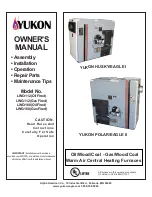
INSTALLATION INSTRUCTIONS
Gas Furnace: (F/G)9MVE
10
440 01 4401 02
Specifications subject to change without notice.
Indoor Combustion Air
©
NFPA & AGA
Standard and Known-Air-Infiltration Rate
Methods
Indoor combustion air
is permitted for combustion, ventilation,
and dilution, if the
Standard
or
Known-Air-Infiltration Rate
Method is used.
WARNING
!
CARBON MONOXIDE POISONING HAZARD
Failure to follow this warning could result in personal injury or
death.
Many homes require air to be supplied from outdoors for
furnace combustion, ventilation, and dilution of flue gases.
The furnace combustion air supply must be provided in
accordance with this instruction manual.
The
Standard
Method:
1. The space has no less volume than 50 cubic feet per
1,000 Btuh (4.8 cubic meters per kW) of the maximum
input ratings for all gas appliances installed in the space
and
2. The air infiltration rate is not known to be less than 0.40
air changes per hour (ACH).
The
Known Air Infiltration Rate
Method shall be used, if the
infiltration rate is known to be:
1. Less than 0.40 ACH and
2. Equal to or greater than 0.10 ACH
Infiltration rates greater than 0.60 ACH shall not be used. The
minimum required volume of the space varies with the number
of ACH and shall be determined per
or Equations 1
and 2. Determine the minimum required volume for each
appliance in the space and add the volumes together to get the
total minimum required volume for the space.
−
Minimum Space Volumes
were determined by
using the following equations from the National Fuel Gas Code
ANSI Z223.1/NFPA 54
−
2012, 9.3.2.2:
1. For
other than fan-assisted appliances
, such as a
draft hood-equipped water heater
A04002
2. For
fan-assisted appliances
such as this furnace:
A04003
If:
I
other
=combined input of all
other than fan-assisted
appliances
in Btuh/hr
I
fan
=combined input of all
fan-assisted appliances
in Btuh/hr
ACH = air changes per hour (ACH shall not exceed 0.60.)
The following requirements apply to the
Standard
Method and
to the
Known Air Infiltration Rate
Method.
1. Adjoining rooms can be considered part of a space if:
a. There are no closable doors between rooms.
b. Combining spaces on same floor level. Each opening
shall have free area of at least 1-in.
2
/1,000 Btuh
(2,000 mm
2
/kW) of the total input rating of all gas
appliances in the space, but not less than 100-in.
2
(0.06 m
2
). One opening shall commence within 12
−
in.
(300 mm) of the ceiling and the second opening shall
commence within 12-in. (300 mm) of the floor. The
minimum dimension of air openings shall be at least
)
c. Combining space on different floor levels. The
volumes of spaces on different floor levels shall be
considered as communicating spaces if connected by
one or more permanent openings in doors or floors
having free area of at least 2
−
in.
2
/1,000 Btuh
(4,400 mm
2
/kW) of total input rating of all
gas appliances.
2. An attic or crawlspace may be considered a space that
freely communicates with the outdoors provided there
are adequate permanent ventilation openings directly to
outdoors having free area of at least 1-in.
2
/4,000 Btuh of
total input rating for all gas appliances in the space.
3. In spaces that use the
Indoor Combustion Air
Method,
infiltration should be adequate to provide air for
combustion, permanent ventilation and dilution of flue
gases. However, in buildings with unusually tight
construction, additional air MUST be provided using
the methods described in the
Outdoor Combustion Air
Method section
.
4. Unusually tight construction is defined as Construction
with:
a. Walls and ceilings exposed to the outdoors have a
continuous, sealed vapor barrier. Openings are
gasketed or sealed and
b. Doors and openable windows are weatherstripped
and
c. Other openings are caulked or sealed. These include
joints around window and door frames, between sole
plates and floors, between wall-ceiling joints, between
wall panels, at penetrations for plumbing, electrical
and gas lines, etc.
Combination of Indoor and Outdoor Air
1. Indoor openings shall comply with the
Indoor
Combustion Air
Method below and,
2. Outdoor openings shall be located as required in the
Outdoor Combustion Air
Method mentioned previously
and,
3. Outdoor openings shall be sized as follows:
a. Calculate the Ratio of all Indoor Space volume
divided by required volume for
Indoor Combustion
Air
Method.
b. Outdoor opening size reduction
Factor
is one minus
the
Ratio
in a. above.
c. Minimum size of Outdoor openings shall be the size
required in
Outdoor Combustion Air
Method above
multiplied by reduction
Factor
in b. above. The
minimum dimension of air openings shall be not less
than 3-in. (80 mm).











































